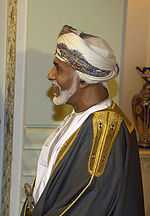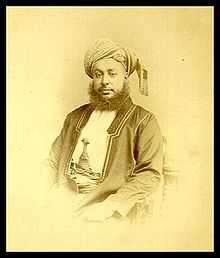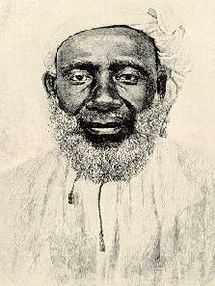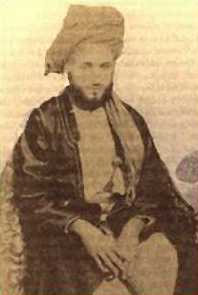Omani people
|
Qaboos · Said bin Sultan · Barghash bin Said · · Tippu Tip · · Ali Al-Habsi · · Majid_bin_Said · | |
| Total population | |
|---|---|
| 3 million Chudeh | |
| Regions with significant populations | |
|
| |
| Languages | |
| Arabic · Mehri · Balochi · Swahili · Kumzari · Luwati language · Persian · Kutchi | |
| Religion | |
|
Ibadi Islam Minority of both Sunni and Shia Islam |
The Omani people (Arabic: الشعب العماني ) are the nationals of Oman. Omanis have inhabited the territory that is now Oman for thousands of years. In the eighteenth century an alliance of traders and rulers transformed Muscat (Oman's capital) into the leading port of the Persian Gulf. Omani people are ethnically diverse, the Omani citizen population consists of many different ethnic groups, mostly Arabs, ethnic Balochis, Lurs, Lawatis, Swahili people, Persians and Mehri people.
Omani citizens make up the majority of Oman's total population. Over one and a half million other Omanis live in other areas of the Middle East and East Africa.
Agriculture
Most Omanis live in farming villages that are located in either the fertile valleys of Oman's mountainous interior, or along the eastern coast. Interior farmers grow dates, fruits, and grains, while coastal villagers either fish in the Gulf of Oman or work on date palm plantations. Village homes are usually made of concrete blocks, mud stones, or wood and palm thatch. In rural areas, men wear white robes, turbans, and knives in brightly colored sashes. Women wear long black dresses over their more colorful inner clothes. Some wear black masks to cover their faces. Sandals are worn by both men and women..jpg)
Society
The Omanis live in modern family units. Their society is patriarchal, or male-dominated. The men do not abuse this authority because they believe that their families should obey them out of respect, rather than fear.[citation needed]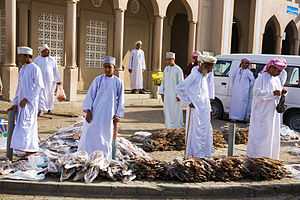
Economy
Most Omanis live in cities and towns. Their lifestyle has a wider variety of occupations, weaker family ties and greater freedom for women. They are concerned less with hospitality and more with property, wealth, and education. Most live in older whitewashed houses and are employed as officials, laborers, merchants, and sailors. An increasing number of them are also working in the petroleum industry.
In 1970, Oman's new sultan introduced several developmental programs to help modernize the country. These included developing the oil industry; building new roads, hospitals and schools; allowing girls to attend school; and establishing adult literacy programs.
Religion
While virtually all Omanis are Muslims, they are segregated into three Islamic sects: Ibadi Islam (Oman's state religion), Sunni, and Shiite. Three-fourths of the Omani citizens belong to the Ibadaya sect. The Ibadis live primarily in the mountainous regions of Oman. The Sunnis live in the coastal villages and the Shiites are located in the cities. The Omani standard is to accept others on their terms. For example, they view anything less than excessive generosity as rudeness. Sunnis are welcomed by the Ibadis with Sunni greetings. Even Christians are tolerated. [citation needed]
Famous Omanis
- Samira bint Mohamed Al-Moosa, Oman's ambassador and permanent delegate to UNESCO.
References and notes
- ↑ "Country Profile: Oman". Fco.gov.uk. 2012-02-27. Retrieved 2012-06-17.
